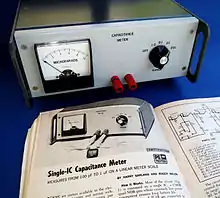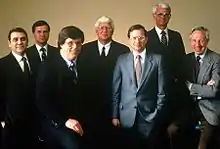Harry Garland | |
|---|---|
 Harry Thomas Garland | |
| Born | 1947 |
| Education | B.A. Kalamazoo College Ph.D. Stanford University |
| Occupation(s) | Scientist, Engineer, Author, Entrepreneur |
| Known for | Co-founder Cromemco, Inc. |
| Call sign | WA8FJW WA6VYT |
Harry T. Garland (born 1947) is a scientist, engineer, author, and entrepreneur who co-founded Cromemco Inc., one of the earliest and most successful microcomputer companies. He received the B.A. degree in mathematics from Kalamazoo College, and the Ph.D. degree in biophysics from Stanford University.[1] Dr. Garland has been recognized as one of the most important innovators in the development of personal computers in Silicon Valley.[2]
Personal life
He is the son of Harry G. Garland, the founder of Garland Manufacturing.
Stanford University
Garland began his graduate work at Stanford University in 1968. Garland's research at Stanford focused on the function of the human brain in controlling voluntary movement.[3] He developed techniques in electromyography for monitoring muscle activity during voluntary movement[4] and worked to delineate the role of the brain and the role of local reflexes in the control of muscles.[5] This led to a deeper understanding of brain function during voluntary movement, and insight into the mode of action of L-DOPA in the treatment of Parkinson's disease.[6]
Garland received the doctoral degree from Stanford in 1972.[7] He was invited by John G. Linvill to join the research staff of the Stanford Electronics Laboratories where he worked on the Optacon project and developed the concept for the next generation Optacon reading aid for the blind.[8] In 1974, he was appointed Assistant Chairman of the Department of Electrical Engineering at Stanford University; he taught graduate courses in electrical engineering and published a textbook in the new field of microprocessor system design.[9]
Popular Electronics

While at Stanford University, Dr. Garland also worked to bring electronics technology to a wider audience. Over a period of six years, in collaboration with Stanford colleague Roger Melen, he wrote a series of articles for Popular Electronics magazine describing original designs that could be built by the electronic hobbyist.[10][11][12][13][14] During this period, Garland and Melen also published two books: Understanding IC Operational Amplifiers and Understanding CMOS Integrated Circuits.[15][16]
The MITS Altair computer, which launched the microcomputer industry, was introduced in January 1975 issue of Popular Electronics magazine.[17] That same issue carried an article by Garland and Melen on solid-state image sensors.[18] The following month they, together with their Stanford colleague Terry Walker, published the design of the world's first completely digital solid-state camera in Popular Electronics, and began work on developing an interface to connect the camera (which they called the “Cyclops”), to the MITS Altair computer.[19] MITS introduced the Cyclops Camera as a peripheral for the Altair Computer in January 1976.[20]
Their next project for Popular Electronics was to develop an interface between the Altair computer and a color television set. They called it the “Dazzler”. Garland and Melen again collaborated with Terry Walker on the hardware design and with Ed Hall, a fellow member of the Homebrew Computer Club, on the software design. The Dazzler appeared on the front cover of the February 1976 issue of Popular Electronics, and Garland and Melen offered a kit of parts for sale.[21]
To support their sales of the Cyclops and the Dazzler, Garland and Melen rented a 200 sq. ft. office in Los Altos, California and formed Cromemco, a company named after the Stanford dormitory where they had both lived as graduate students.[22]
Cromemco

Dr. Garland was president of Cromemco from its incorporation in 1976 until its sale in 1987. From the original Cyclops and Dazzler products the company developed a full line of microcomputer systems that were rated as the most reliable in the industry.[23] Cromemco systems became the systems of choice for broadcast television graphics,[24] were widely deployed as Mission Planning Systems by the United States Air Force,[25][26] and were the first microcomputer systems widely distributed in China.[27][28]
By 1980 Cromemco occupied 200,000 sq. ft. of manufacturing and office space in Mountain View, California, and In 1981 Inc. Magazine ranked Cromemco in the top 10 fastest growing privately held companies in the U.S.[29] Garland achieved this growth without accepting any external equity financing.[30]
The success of Cromemco products in television broadcast applications was based on a successor product to the original Dazzler, called the "Super Dazzler" interface (SDI).[31] ColorGraphics Weather Systems, a customer of Cromemco, developed software for the SDI specifically for television weather graphics and digital art creation.[32][33] Dynatech, the parent company of ColorGraphics Weather Systems, sought to acquire Cromemco to provide the computer and graphics systems for their broadcast division, and purchased Cromemco in 1987.[34]
Further activity
In 1990 Dr. Garland was invited by Dr. Hajime Mitarai, president of Canon Inc., to help establish a new R&D center for Canon in Silicon Valley.[35][36] Dr. Garland served as Vice President of this new center, Canon Research Center America, from 1990 to 2001. At Canon he developed technology for medical digital radiography equipment, and worked on standards to integrate this equipment with hospital and radiology information systems.[37] He served on the Kalamazoo College Board of Trustees from 1987 to 2005, and on the board of Industry Initiatives for Science and Math Education (IISME) from 1996 to 2010 including a term as president of that board.[38][39] In 2002 Dr. Garland co-founded Garland Actuarial LLC with his wife, Roberta J. Garland, and serves as chairman of the firm.
Recognition
Dr. Garland's contributions to the computer industry have been recognized in numerous books[1][2][22][40] and on television, including appearances on the Financial News Network,[41] The Personal Computer Show,[42] The Screen Savers,[43] and in the PBS documentary Triumph of the Nerds.[44] He has received the Sesquicentennial Award from Kalamazoo College and the Distinguished Alumni Award.[45][46] He is the author of three books: Understanding IC Operational Amplifiers,[15] Understanding CMOS Integrated Circuits,[16] and Introduction to Microprocessor System Design.[9] He has been awarded 20 U.S. Patents.[47]
References
- 1 2 Levering, Robert; Katz, Michael; Moskowitz, Milton (1984). The Computer Entrepreneurs. New American Library. pp. 36–40. ISBN 0-453-00477-6.
- 1 2 Piscione, Deborah (2013). Secrets of Silicon Valley. Palgrave MacMillan. p. 80. ISBN 978-1-137-27917-0.
- ↑ Garland, H.; R.W. Angel (1971). "Spinal and Supraspinal Factors in Voluntary Movement". Exptl. Neurology. 33 (2): 343–350. doi:10.1016/0014-4886(71)90026-4. PMID 5124954.
- ↑ Garland, H.; R.W. Angel; R. Melen (1972). "A State-Variable Averaging Filter for Electromyogram Processing". Medical and Biological Engineering. 10 (4): 559–560. doi:10.1007/bf02474207. PMID 5074860. S2CID 28351473.
- ↑ Garland, H.; R.W. Angel; W.E. Moore (1972). "Activity of Triceps Brachii During Voluntary Elbow Extension: Effect of Lidocaine Blockade of Elbow Flexors". Exptl. Neurology. 37 (1): 231–235. doi:10.1016/0014-4886(72)90239-7. PMID 5077560.
- ↑ Angel, R.W.; W. Alston; H. Garland (1971). "L-Dopa and Error Correction Time in Parkinson's Disease". Neurology. 21 (12): 1255–1260. doi:10.1212/wnl.21.12.1255. PMID 5167317. S2CID 35269921.
- ↑ Stanford Alumni Association (1989). Stanford Alumni Directory Centennial Edition. p. 443.
- ↑ Linvill, John G. (March 1973). Final Report: Research and development of Tactile Facsimile Reading Aid for the Blind. Stanford Electronics Laboratories. pp. 24–25. Retrieved 6 November 2017.
Dr. Garland suggested that the Optacon could be more effective if the camera and tactile screen were incorporated into a single hand-held unit.
- 1 2 Garland, Harry (1979). Introduction to Microprocessor System Design. New York: McGraw-Hill. ISBN 0-07-022871-X.
- ↑ Melen, Roger; Garland, Harry (1971). "Build the Fil-oscillator". Popular Electronics. 34 (5): 58–62.
- ↑ Garland, Harry; Melen, Roger (1971). "Add Triggered Sweep to your Scope". Popular Electronics. 35 (1): 61–66.
- ↑ Garland, Harry; Melen, Roger (1971). "Build the Muscle Whistler". Popular Electronics. 35 (5): 60–62.
- ↑ Garland, Harry; Melen, Roger (1973). "Build a Low-Cost Op Amp Tester". Popular Electronics Including Electronics World. 4 (6): 34–35.
- ↑ Garland, Harry; Melen, Roger (1974). "A Single-IC Capacitance Meter". Popular Electronics Including Electronics World. 5 (2): 44–45.
- 1 2 Melen, Roger; Garland, Harry (1971). Understanding IC Operational Amplifiers. Howard W. Sams. ISBN 0-672-22484-4.
- 1 2 Melen, Roger; Garland, Harry (1975). Understanding CMOS Integrated Circuits. Howard W. Sams. ISBN 0-672-21598-5.
- ↑ Garland, Harry (March 1977). "Design Innovations in Personal Computers". Computer. IEEE Computer Society. 10 (3): 24. doi:10.1109/c-m.1977.217669. S2CID 32243439.
There is little question that the current enthusiasm in personal computing was catalyzed by the introduction of the MITS Altair computer kit in January 1975.
- ↑ Garland, Harry; Melen, Roger (1975). "Solid-state Image Sensors - TV Camera Tube Successor?". Popular Electronics. 7 (1): 27–31.
- ↑ Walker, Terry; Garland, Harry; Melen, Roger (1975). "Build Cyclops" (PDF). Popular Electronics. 7 (2): 43–45.
- ↑ Allen, Paul (2011). Idea Man: a memoir by the cofounder of Microsoft. New York: Penguin Group. p. 108. ISBN 978-1-59184-537-9.
The Altair even debuted a digital camera back in 1976.
- ↑ Walker, Terry; Melen, Roger; Garland, Harry; Hall, Ed (1976). "Build the TV Dazzler". Popular Electronics. 9 (2): 31–40.
- 1 2 Levy, Steven (1984). Hackers: Heroes of the Computer Revolution. Garden City, NY: Anchor Press/Doubleday. p. 202. ISBN 0-385-19195-2.
- ↑ 1977 Computer Store Survey. Westlake Village: Image Resource. 1977. p. 25.
- ↑ "Cromemco Computer Graphics 1987". wn.com. Retrieved 2012-02-10.
- ↑ Kuhman, Robert. "The Cro's Nest RCP/M-RBBS". www.kuhmann.com. Retrieved 2012-02-10.
- ↑ "USAF will equip its tactical fighter squadrons with a mission planning system". Aviation Week & Space Technology. 126 (22): 105. June 1, 1987.
- ↑ Ost, Laura (November 9, 1979). "Cromemco Saw the Future for Computers Overseas". The Peninsula Times Tribune: E1, E3.
- ↑ Williams, Dennis A.; Lubenow, Gerald C.; Findlay-Brown, Ian (February 18, 1985). "China Looks West to Learn". Newsweek: 84.
- ↑ Ketchum Jr., Bradford W. (December 1981). "The INC. Private 100". Inc. 3 (12): 35–44.
- ↑ Mamis, Robert A. (November 1981). "Cromemco's never taken a dime from anyone". Inc. 3 (11): 117–122.
- ↑ Fox, Tom (December 1979). "Cromemco's Superdazzler". Interface Age. 4 (12): 74–77.
- ↑ Melton, Louise (November 1984). "Video Processing". Computer & Electronics. 22 (11): 96.
Some 80% of all the television stations in the country use Colorgraphics's LiveLine systems to generate weather, news and sports graphics. The basic system is built around Cromemco microcomputers.
- ↑ "Cromemco Computer Graphics 1987". YouTube. Retrieved 2014-10-31.
- ↑ "Mergers and Acquisitions". Computer World. 21 (12): 108. March 23, 1987. Retrieved 1 November 2017.
- ↑ Johnstone, Bob (October 1994). "Canon, Lone Wolf". Wired. Vol. 2, no. 10. p. 147.
- ↑ Kumagai, Jean (1991). "Several Japanese Corporations Establish New Labs in United States". Physics Today. 44 (2): 81. Bibcode:1991PhT....44b..81K. doi:10.1063/1.2809989.
- ↑ Garland, H.; B. Cavanaugh; S. Lavoie; R. Cecil; A. Leontiev; B. Hayes; J. Veprauskas (May 1999). "Interfacing RIS to the Modality: An Integrated Approach". Journal of Digital Imaging. 12 (2): 91–92. doi:10.1007/bf03168766. PMC 3452882. PMID 10342177.
- ↑ "Emeriti Trustees". Kalamazoo College. Retrieved 22 February 2019.
- ↑ "IISME Annual report". Internet Archives. Retrieved 22 February 2019.
- ↑ Freiberger, Paul; Swaine, Michael (2000). Fire in the Valley: The Making of The Personal Computer (Second ed.). McGraw-Hill. ISBN 0-07-135892-7.
- ↑ "Cromemco Personal Computer History 1982". YouTube. Retrieved 2013-02-21.
- ↑ "Cromemco Computer Graphics 1983". YouTube. Retrieved 2013-02-21.
- ↑ "TSS: Homebrew Computer Club 1/16/2004 (1of4)". YouTube. Retrieved 2013-02-21.
- ↑ "Cromemco Retrospective 1996". YouTube. Retrieved 2013-02-21.
- ↑ "More Honors: Dr. Harry Garland". The Peninsula Times Tribune. July 31, 1983. p. C-6.
- ↑ "Distinguished Alumni Award 1983". Kalamazoo College. Retrieved 2013-02-21.
- ↑ "USPTO Patent Full-Text and Image Database". USPTO. Retrieved 2013-02-21.